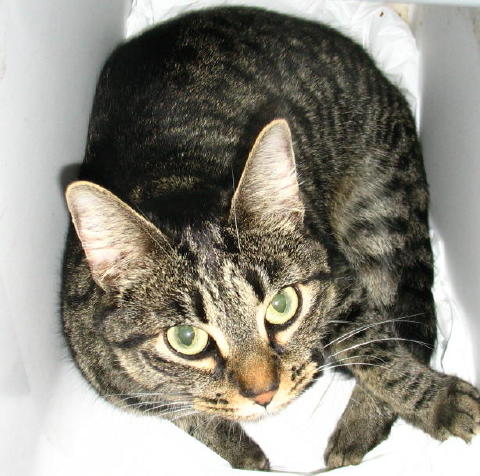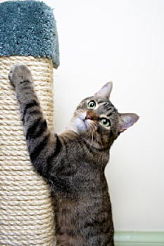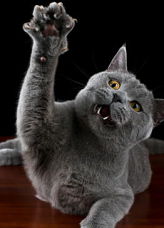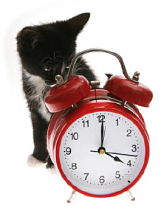Cat Language - Cat Talk - Cat Chat

Cat language...many people believe cats are loners and in the wild where food is scarce, they do spend a lot of their time alone. Despite the aloofness at times, they can be social animals and they use a host of communication skills to maintain social harmony. Their language has evolved to meet cats’ needs as territorial animals.
In the wild, a cat needs a hunting ground large enough to supply a steady dinner of prey animals and it defends its territory against intruding cats. Cats have learned to communicate to avoid physical contact during territorial disputes and to lessen the chance of serious injury if combat does indeed happen.
Cat language is frequently demonstrative. You return home after a long day at work and flop onto the sofa ...your furry buddy hops up happily and starts head-butting your chin, nuzzling your ears, and licking your cheek. She kneads her paws deeply into your chest, she turns forward, tail straight up, positioning her rear end just inches from your face, all the while purring like a rusty gate.
You guide her around to face you, pet her telling her you love her. There's nothing wrong here, she's just being a cat. although from a human perspective her behavior might seem indulgent...she is bestowing on you, her dear human companion, one of the highest compliments of catdom...the gift of full participation in her feline inner circle.
We don't really know how our cats perceive us...as helpless kittens, all-powerful maternal figures, or some combination of both. But we do know that they regard us as social companions, as part of their family circle.
Cat language behaviors such as licking, nuzzling, head-butting, and similar actions are all ways in which cats create and maintain a familiar "group scent" or "home scent". The fact that you are back from work provides your "furball" with an irresistible opportunity to renew, reinforce and revel in that cozy group scent.
Cat language scents have meaning and our cats move in a scent-saturated world. Cats have a much more highly developed sense of smell than people and often use scents to exchange messages with other cats. By scent marking trees or other objects in its territory, a can is doing the equivalent of posting “No Trespassing” signs, warning potential feline intruders that they risk a fight if they don’t take a detour. Unfortunately, there is sometimes a breakdown in communications because this urine spraying form of feline communication is unwelcome in the home.
Once urine marking begins, a cat can quickly fall into the habit of routinely refreshing its mark on the sofa or drapes and sometimes this leads to such owner frustration that the cat winds up in a shelter. Owners of such “hard core” markers like my Max, may need the help of a veterinarian or animal behaviorist to change the cat’s behavior.
Extremely subtle scents offer cats much meaning, reassurance, and information. Humans, on the other hand, have a much narrower range of interpretation of scents, often finding cats' scent obsessions and obvious pleasure in particular odors uncomfortable or puzzling. Keep in mind that cats have about 67 million odor-analyzing cells, as opposed to our paltry 5 to 20 million.
Plus, they have a supplemental "scent-tasting" system, the Jacobson's or vomeronasal organs that are located between the hard palate of the mouth and the nasal septum, these organs let the cat "taste" odor molecules such as pheromones and other chemical substances often related to appetite and sexual activities. This is the cat's primary means of recognizing individuals, objects, activities, and threats in their environment.
Despite their reputation for aloofness, cats are a high-contact species.
Among themselves, cats living together frequently touch noses in
greeting, rub cheeks and foreheads, sniff one another, brush gently
while passing side by side and engage in mutual grooming.
These cat language activities all assist in the mixing, mingling, and refreshing of the familiar group scent. These small rituals, repeated dozens of times daily, are no less vital and reassuring for all their subtlety. By extending these scent-oriented and touching behaviors to human companions, cats are acknowledging their full acceptance of those favored humans into their social sphere.
Cat owners who make an effort to understand these cat language behaviors from a feline point of view are rewarded with a deeper and more complex relationship with their cats. These intimate feline gestures are gifts of love, trust, friendship, social approval, and acceptance of you as a beloved companion.
When the "furball" sticks her rump in your face she's replicating a behavior typical of the kitten-mother cat relationship. She's not regressing to kittenhood but she's building on her early life experience of trust and safety, extending it and transferring some of those warm feelings to you. Cat language behavior is at once olfactory, gustatory, and investigatory.
While enjoying a comforting experience your cat is not only trying to find out where you've been and what you've been up to, but is also welcoming you back and re-initiating you into her scent group using cat language. You will find a few books on this topic listed below that are available at Amazon.
The discomfort associated with typical feline social behavior can be physical as well as psychological. Although a few soft licks to your chin might be welcome and endearing, 15 minutes of determined cheek-licking by a raspy tongue designed to rip meat from bone can be downright painful. Some cats bestow a soft, gentle, held-back bite to express affection, but any escalation of that particular activity can be disturbing.
The drooling that often accompanies kneading is a sign of especially intense emotional involvement. The cat may even seem to be in a sort of trance. When this happens, the cat sometimes will attack the owner suddenly, making the owner upset and unhappy but it is a natural response to the stimulation of mating-related hormones. Cat owners should be very careful about their response and shouldn't punish these behaviors. Even when painful, and upsetting, these behaviors are motivated by the cat's desire to be friendly.
The key is to provide an acceptable alternative so that the cat will still be able to have an enjoyable interaction with the owner. Cat language behaviors you respond to with praise or attention...even negative attention...will be reinforced, while those you ignore will tend to diminish. Any distraction or diversion is more effective than yelling or punishing.
Scratching is another form of feline marking (cat language) which can also become a problem in the home. A cat’s natural inclination to scratch tree trunks or other convenient objects in the environment serves both physical and social needs. Scratching removes the worn outer layers of a cat’s claws and exposed a new sharp claw tip. As the cat claws, it also exercises and stretches muscles.
Outdoors, a well-scratched tree serves a cat’s social needs as a visible territorial marker. Scent, deposited by glands in the cat’s paw as it scratches, adds a reinforcing olfactory element to the cat’s visible claw-mark message. Problems arise when your cat carries out the behavioral action in your home.
To your cat, the arm of a sofa… a prominent object in a well-traveled area…is the ideal place to scratch. Rather than fight feline nature by punished the cat for scratching, offer your cat acceptable alternatives.
Have at least one scratching post and provide this before the clawing of furniture starts. If you cat has already claimed the arm of a sofa simply place the scratching post in front of it and then gradually moved it further away over a period of days or weeks.
Another option which I used for a period of time was putting the plastic claw covers on two of the cats until they stopped attempting to scratch furniture. They are hilarious to look at when you get colored ones. I got purple ones and it looked amusing to see the cats looking like they had been to the nail salon.
They are easy to attach. You put a drop of the glue (that comes with them) in each nail cap and slide it onto your cats nail. When your cat nail grows out you will find the colored nail on the floor or somewhere nearby and you repeat the process.
Because our cats' affectionate and care-taking behaviors are so highly pleasurable and deeply motivated, it's difficult to extinguish them completely, even if we want to. But for cat owners who would like to modify or minimize certain cat language behaviors that cause them discomfort, a multifaceted approach is suggested consisting of patience, diversion, distraction, displacement and prevention.
Many cats are satisfied with a relatively brief, if intense interaction. Let the cat indulge herself in these cat language behaviors for a time. Chances are, she'll soon decide she's had enough and go on to something else.
If the cat keeps up or escalates the behavior beyond your tolerance, divert her attention by standing up and moving about a bit, or change positions to help break the pattern or context in which the unwanted behavior was begun. Try making whatever part of you the cat is focusing on less accessible, in a friendly way.
Or, you can try to redirect the cat's attention to a favorite toy or active game, distracting her with an alternate form of interaction more acceptable to you. Ideally, the alternative activity should be one that the cat finds as pleasurable and motivated as the cat language behavior you're trying to stop.
It's always easier to prevent the onset of an unwanted pattern than to try to extinguish an established routine. By carefully observing your cat's habits and predilections, you can learn to recognize when she's about to engage in a cat language activity you want to discourage. If flopping down on the sofa at the end of the day signals the cat to begin a dedicated nuzzling session, try to change your routine.
Go to another room, or sit in a different chair. Another technique is to divert the behavior onto another object, a sort of scented "stand-in" for you. Imbue a small soft toy with your own scent, or provide the cat with an un-laundered sweatshirt or other article of your clothing. Some cats will appreciate access to your dirty socks. Then, when the cat's behavior becomes a bit too much for you, refocus it on the substitute.
To stop an unwanted cat language activity immediately, passively stand up and let the cat drop to the floor. Don't handle the cat,even to push him away, as he may well interpret this as an acknowledgment or even reward for the behavior. What the cat is after is interaction and refusing interaction will tend to minimize that particular behavior. Consider altering your own "scent signature" to a lesser one but one that is still comfortable to the cat.
Because scent is so meaningful to cats, and because they are so much more sensitive to odors than humans are, we often forget that odors which are barely noticeable to us can be powerful signifiers to cats. Some soaps, lotions, colognes, and even deodorants can partially mimic feline pheromones, causing cats to react according to deeply-held natural mating or maternal behavior patterns. If you have a particularly persistent nuzzler or neck licker, try changing brands or minimizing your use of scented products.
Another cat language is where cats also use their bodies to “speak”. You can look at a cat and tell if it is aggressive toward you or friendly, whether it is dominant toward you or a ‘scaredy cat’ acting defensively. A cat’s body posture proclaims whether it welcomes a closer approach….or not. A cat showing an offensive threat posture typically stands straight up, with ears erect and angled to the sides and whiskers pointing forward, as it attempts to stare down its adversary through slit like pupils.
A cat showing a defensive threat posture typically crouches or leans back from its opponent with its ears flattened against its head, whiskers pointing backward, and widely dilated eyes staring at its opponent as it waits for an opportunity to flee…or fight if it must. Another type of feline threat display is the familiar “Halloween cat” posture. The cat stands sideways with its fur erect (piloerection) and its back in a high arch. Cats rarely use this posture in cat-to-cat confrontations.
This feline body posture, along with a lot of hissing and spitting, is usually reserved for other species if they approach too closely. It makes the cat look as large and threatening as possible and is designed to convey a message of extreme danger in cat language that most animals understand.
Felines are creatures of habit. They adore ritual and routine. Try to establish new patterns and rituals that answer your own needs and the cat's. Stress caused by the persistence of a cat language behavior that makes you uncomfortable or upset may, over time, erode the bond between you and your cat, or even keep that close, loving bond from developing initially.
By establishing interactive rituals that are pleasant and satisfying for both of you, you and your cat can deepen and enhance your special bond and you can more graciously accept those special feline gifts of love and trust.
Talking about gifts...what about the mouse or bird that is left for you to find? The cat who brings back such presents to the owner does so because she feels that the prey will be safe there. The female cat may also be trying to provide the owner with food, as they would do for their own kittens.
Bringing home prey has a strong maternal care taking component. Some cat owners might be less than thrilled with a gift of a dead rodent, but from the feline perspective, this gift, like any other graciously proffered gift, calls for gratitude and respect no matter how squeamish you might feel.
Thank your cat, praise her hunting prowess, then distract her attention with a treat or toy while you discreetly dispose of the prey. I find it amusing that frequently I wake up in the morning with a fuzzy toy by my head on the pillow.
During the night Revlon or Blaze, both indoor cats, are sharing one of their mice or bird toys with me. I never know which one gifted me on any particular night but I find it touching....and I'm thankful they are indoor cats...........but in cat language they are sharing an item they treasure with me.
Related Articles......
Return from Cat Language to Cat Health Home Page
Having trouble finding what you need? Cat Health Index & Site Map
OR
Do you have a question to ask?...Questions
OR
Do you have a cat story to share?...Simply click here to go to that page!
Copyright@2010-2020 All rights reserved.Cat-health-detective.com
This website is information only. Consult a veterinarian for medical assistance

"Like Us" on Facebook
or...
"Like Us" here




















